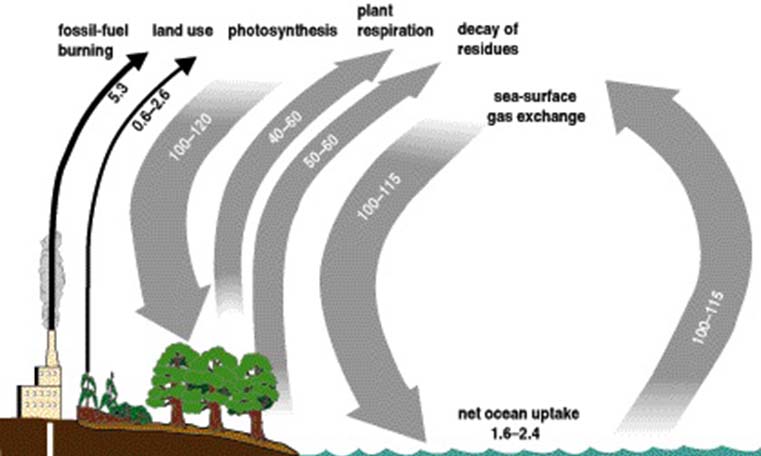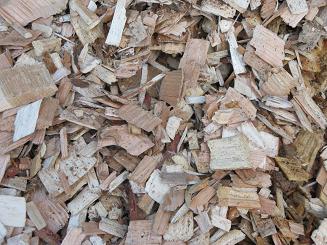 A successful and short- and mid-term response to the threat of climate change will be comprised of renewable energy options such as woody biomass.
A successful and short- and mid-term response to the threat of climate change will be comprised of renewable energy options such as woody biomass.by Charlie Blinn, Diomy Zamora, and EL Taylor
Background
The use of biomass for energy in place of fossil fuels such as coal is becoming increasingly important because the substitution of woody biomass for fossil fuels can reduce greenhouse gas (GHG) emissions into our atmosphere (air). Our atmosphere sustains life on Earth, maintains warmth, and shields the Earth from harmful radiation emitted by the Sun. With the advent of the Industrial Revolution, the mixture of gases and particles in our atmosphere began to change. While the primary gases in our atmosphere are nitrogen (N,2) and oxygen (O2), the greenhouses gases water vapor, carbon dioxide (CO2), methane (CH4), nitrous oxide (NOx), and ozone act like a heat blanket and are important in insulating Earth’s surface.
The burning of fossil fuels has considerably increased atmospheric carbon and other GHGs since the beginning of the Industrial Revolution. When burned, coal and other fossil fuels release CO2 and other gases into the Earth’s atmosphere where they trap and reflect more heat than would normally occur which may result in global climate change. Because this carbon came from fossilized storage (carbon that was produced and stored millions of years ago), it’s release represents a net addition into the atmosphere at a quantity more than can be sequestered (stored) by today’s plants, soils, and oceans.
The buildup of human-caused GHGs in our atmosphere from burning fossil fuels can be mitigated through the process of carbon sequestration, or removing CO2 from the atmosphere into long-lived carbon pools such as trees. The process of photosynthesis combines atmospheric CO2 with water, releasing oxygen into the atmosphere and incorporating the carbon atoms into the plant cells. As a result, this carbon neutral process can help displace CO2 emissions from burning fossil fuels (Figure 1). Finding sustainable ways to meet growing energy needs while reducing GHG emissions is one way to address the threat of climate change. While wind and solar power are increasing in popularity and prevalence, so is biomass. Versatile enough to provide heat, power, electricity, transportation fuels, and other products, woody biomass can be used to produce energy on a larger scale than solar and wind, in many cases. It is probable that a successful and sustainable short- and mid-term response to the threat of climate change will be comprised of a suite of renewable energy options that includes woody biomass.

Benefits
Woody biomass emits less GHG emissions than fossil fuels and if sources are replanted on a sustainable basis, the process of using woody biomass is essentially carbon-neutral (Figures 1). For every British thermal unit (Btu) produced by cellulosic ethanol from wood, grasses, or the non-edible parts of plants rather than by gasoline, there is a total lifecycle greenhouse gas reduction of 90.9% (Malmsheimer et al., 2008). About 40 million dry tons of logging residues are available for bioenergy production in the United States annually. Utilizing these residues would displace about 17.6 million tons of carbon annually, or 3% of the total current carbon emissions from the electrical sector (Gan and Smith 2006). The cost of using logging residues for carbon displacement is $60 to $70/ton, considerably less than other mitigation options of $83 to $164/ton (IPCC, 2001). Follow the links below to find out more about the environmental impacts of woody biomass utilization.
- Air Quality and Human Health
- Water Quality and Quantity
- Wildfire Prevention and Forest Health
- Biodiversity and Wildlife
- Wood Energy and Soil Productivity
- Wood Energy and Invasive Species
References
- Some of this content is derived from Foster CD, Gan J, Mayfield C. 2007. Advantages of Woody Biomass Utilization. Pages 35-38. In: Hubbard, W.; L. Biles; C. Mayfield; S. Ashton (Eds.). 2007. Sustainable Forestry for Bioenergy and Bio-based Products: Trainers Curriculum Notebook. Athens, GA: Southern Forest Research Partnership, Inc. [pdf]
- Gan J, Smith CT. 2006. Availability of logging residues and potential for electricity production and carbon displacement in the US. Biomass and Bioenergy 30(12):1011–1020.
- Intergovernmental Panel on Climate Change. 2001. Climate Change 2001: Mitigation Summary for Policy Makers. http://www.ipc.ch Date accessed: October 24, 2005.
